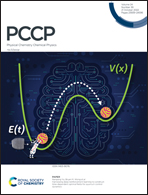Emulating synaptic behavior in surface-functionalized MoS2 through modulation of interfacial charge transfer via external stimuli†
Abstract
Neuromorphic computing requires materials able to yield electronic switching behavior in response to external stimuli. Transition-metal dichalcogenides surfaces covered by partial or full monolayers of molecular species have shown promise due to their potential for tunable interfacial charge transfer. Here, we demonstrate a class of molecules able to position MoS2 surfaces on the cusp of electronic instabilities. Density functional theory (DFT) calculations and ab initio molecular dynamics simulations are used to study the interaction of four reduced pyridinium-derived pi-conjugated molecules with the pristine basal planes of MoS2, by exploring the dynamical evolution of the system at room temperature with regards to the effective band gap, radius of gyration (rog), and charge transfer. Computed rog profiles show that low concentrations of small reduced methyl viologen molecules have high mobilities on top of the surface of the basal plane at room temperature leading to unstable surface deposition, whereas a full monolayer of larger fused-ring molecules deposited on the basal surface shows greater thermal stability. DFT analyses show these larger reduced pyridinium derivatives promote n-type doping on the basal plane due to a built-in electric field, which can be systematically tuned to induce a switching effect, opening and closing a bandgap and providing a fundamental means of driving electronic instabilities needed for emulating neuronal functionality.



 Please wait while we load your content...
Please wait while we load your content...